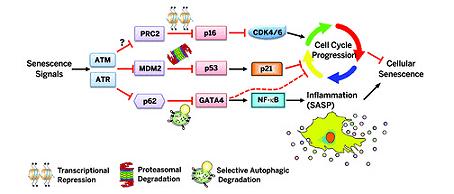Science :确认控制细胞衰老的关键机制
 2016-05-25来源:未知
2016-05-25来源:未知

人们对细胞衰老所知甚少,这是异常细胞的一个不再能通过细胞周期发展的状态,但新的研究发现了一个诱导该生物学过程的关键机制。衰老细胞的积累被认为会促进与老化有关的疾病,其中包括癌症和神经退行性病变;因此,了解这一细胞劣化的基础机制对人体健康具有重要的意义。随着细胞进入一种衰老状态,它们会在基因表达方面展示出广泛的改变,其中包括促炎反应,其特征是分泌的炎性细胞因子表达增加。这样的细胞具有所谓的衰老相关性分泌表型(SASP)。为了更多地了解这一过程,Chanhee Kang等人在人类成纤维细胞中诱导衰老,并寻找在衰老细胞中高度表达但在非衰老细胞中却没有高度表达的基因变异。他们发现,一个特别的转录因子——GATA4在激活衰老过程中起着关键作用。进一步的研究揭示,GATA4通常受到一个降解细胞成分过程(自吞噬)的抑制,但当细胞老化或受损时,这一GATA4的受控的耗竭停止,而衰老过程开始接管。这些发现帮助解决了一个谜团-,即先前有研究发现,自吞噬是衰老过程所需的,而某些证据提示,自吞噬可帮助抑制衰老过程。但Kang和同事的结果表明,一种选择过程在起作用:一般性的自吞噬可导致衰老,而GATA4的靶向自吞噬则可阻止衰老。确实,某些自吞噬成分的消耗可增加GATA4 蛋白的丰度。进一步的操控揭示,GATA4 的表达诱发了与SASP相关基因的表达,而GATA4的耗竭可抑制数个SASP基因的表达。由Liam Cassidy 和 Masashi Narita撰写的《视角》更详细地讨论了这些发现。
原文链接:The DNA damage response activates inflammation and senescence by protecting GATA4 from selective autophagy
原文摘要:Cellular senescence is a terminal stress-activated program controlled by the p53 and p16INK4a tumor suppressor proteins. A striking feature of senescence is the senescence-associated secretory phenotype (SASP), a pro-inflammatory response linked to tumor promotion and aging. We have identified the transcription factor GATA4 as a senescence and SASP regulator. GATA4 is stabilized in cells undergoing senescence and is required for the SASP. Normally, GATA4 is degraded by p62-mediated selective autophagy, but this regulation is suppressed during senescence, thereby stabilizing GATA4. GATA4 in turn activates the transcription factor NF-κB to initiate the SASP and facilitate senescence. GATA4 activation depends on the DNA damage response regulators ATM and ATR, but not on p53 or p16INK4a. GATA4 accumulates in multiple tissues, including the aging brain, and could contribute to aging and its associated inflammation.



